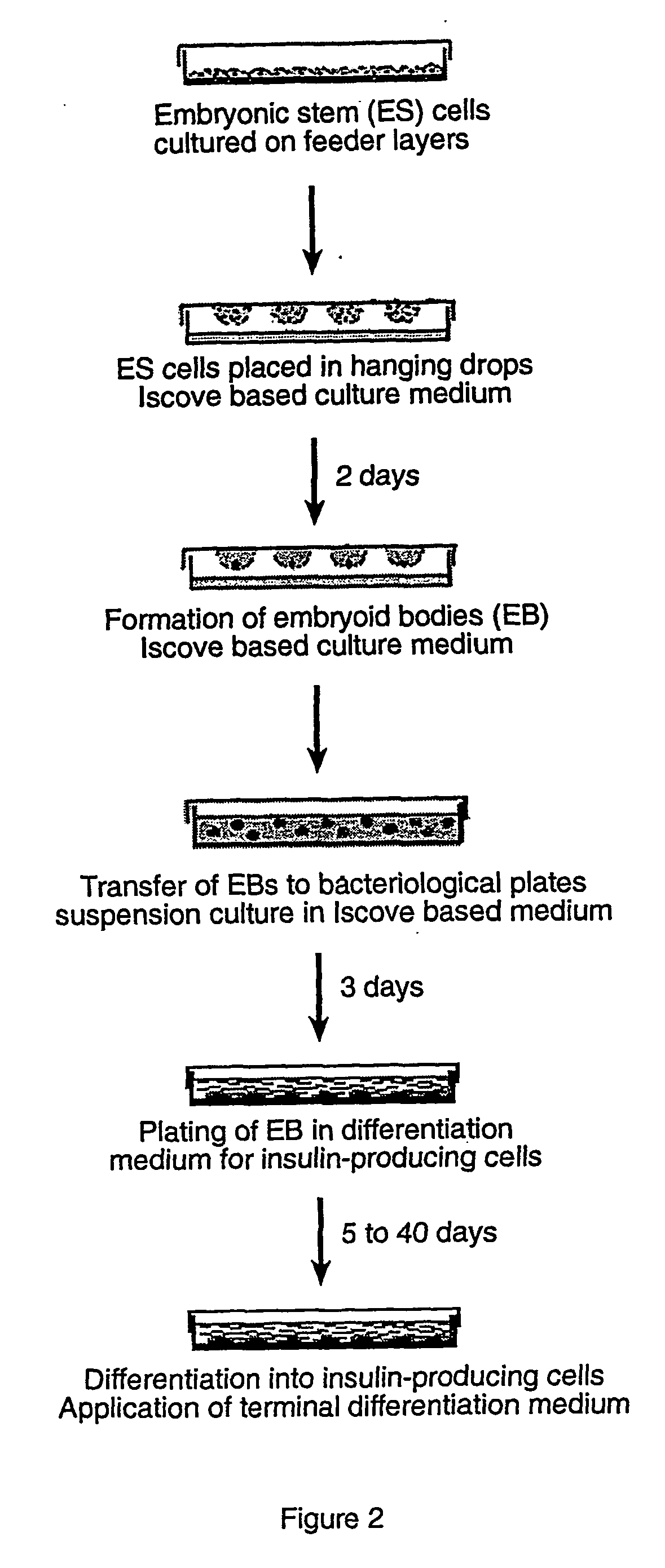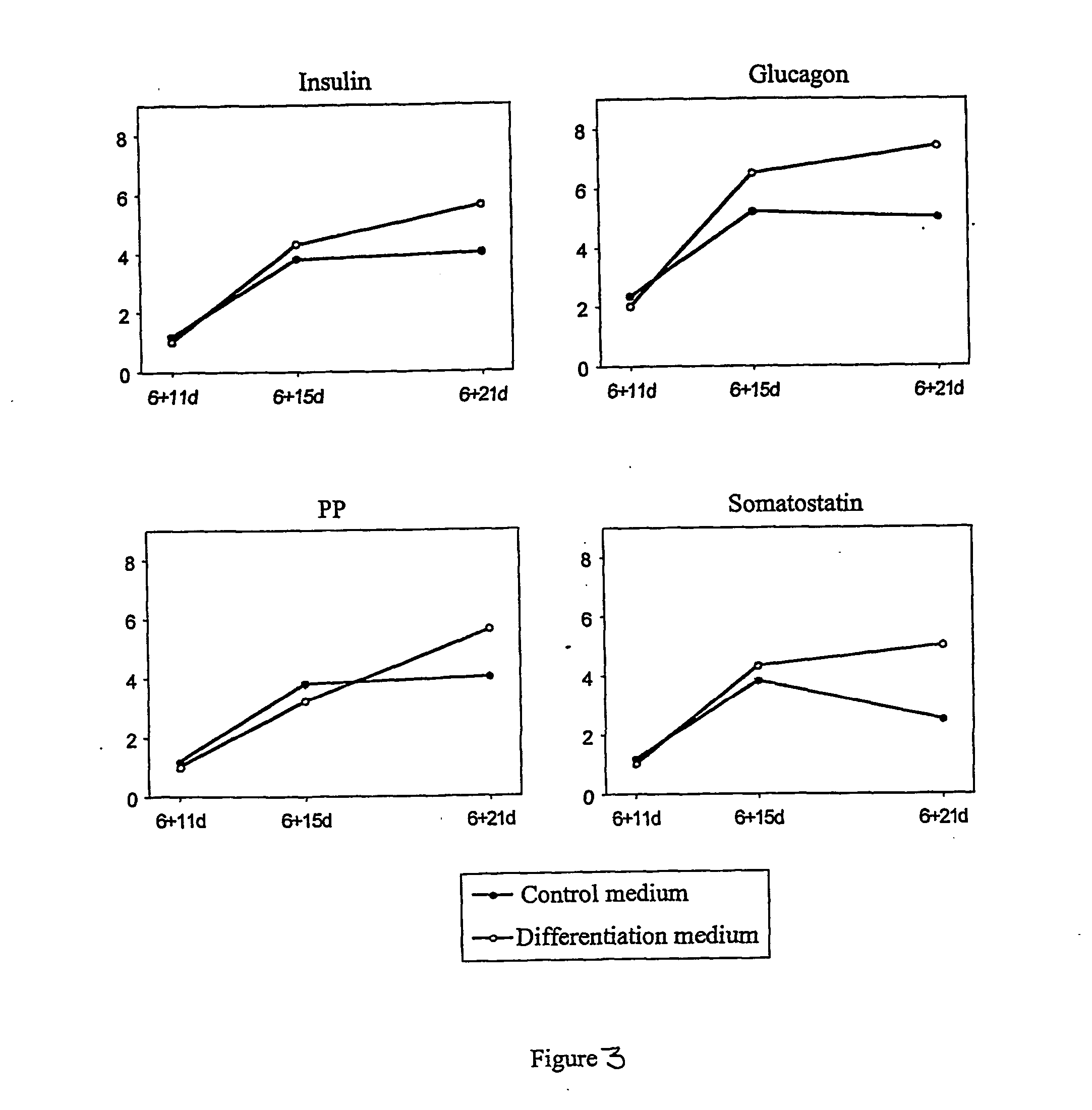Method for differentiating stem cells into insulin-producing cells
- Summary
- Abstract
- Description
- Claims
- Application Information
AI Technical Summary
Benefits of technology
Problems solved by technology
Method used
Image
Examples
example 1
[0063] Generation of ES Cells Expressing the Pdx1 or Pax6 Gene.
[0064] The mouse R1 ES cells (Nagy et al. (1993) Proc. Natl. Acad. Sci. USA. 90:8424-8) were electroporated with the Pax6 or the Pdx1 gene under the control of the CMV promoter (see FIG. 1) and the neomycin resistance gene under the control of the phosphoglycerate kinase I promoter (pGK-1). ES cells are cultured in Dulbecco's modified Eagle's medium (DMEM, Life Technologies) containing 4.5 g / l glucose, 10−4 M beta-Mercaptoethanol, 2 nM glutamine, 1% non essential amino acids, 1 nM Na-pyruvate, 15% FCS and 500 U / ml leukaemia inhibitory factor (LIF). Briefly, approximately 107 ES cells resuspended in 0.8 ml phosphate buffered saline (PBS) containing 25 μg / ml of linearized expression vector and electroporated with one pulse of 500 μF and 250 volts at room temperature using a Gene Pulser electroporation apparatus (BioRad). Five minutes after electroporation, ES cells are plated on 8.5 cm petri dishes containing fibroblastic...
example 2
[0065] Differentiation of ES Cells into Insulin-Producing Cells.
[0066] The ES cell line R1 (wild type, wt) and ES cells constitutively expressing Pdx1 (Pdx1+) were cultivated as embryoid bodies (EB; EBs) by the hanging drops method (FIG. 2). Briefly, approximately 600 cells were placed in drops of 20 μl medium composed of Iscove modified Dulbecco's medium (IMDM, Gibco) supplemented with 20% FCS, L-glutamine, non-essential amino acids and alpha-monothioglycerol (Sigma, Steinheim, Germany; final concentration 450 μM). Drops were placed on the lids of petri dishes filled with phosphate-buffered saline (PBS). The EBs were allowed to form in hanging drops cultures for 2 days and then transferred for three days to suspension cultures in bacteriological petri dishes (Greiner, Germany). At day 5, EBs were plated separately onto gelatin-coated 24-well plates containing a differentiation medium prepared with a base of Iscove modified Dulbecco's medium (IMDM, Gibco) supplemented with 20% FCS,...
example 3
[0067] Hormonal Expression in Differentiated ES Cells.
[0068] Expression of insulin, glucagon, somatostatin and pancreatic polypeptide (PP) was verified by immunofluorescence in differentiated wt and Pdx1+ ES cells. Immunofluorescence was performed according to standard protocols (see Wobus et al.: In Vitro Differentiation of Embryonic Stem Cells and Analysis of Cellular Phenotypes, In: Tymms, M. J. and Kola, I. (Eds.) Gene Knockout Protocols, vol. 158, Methods in Molecular Biology, Humana Press, Totowa, N.J., 2001). Briefly, differentiated wt or Pdx1+ ES cells are grown on cover slips and rinsed twice with PBS and fixed with methanol: acetone 7:3 at −20° C. for 10 min. The following antibodies were used: Mouse anti-insulin (Sigma-Aldrich Co.), rabbit anti-glucagon (Dako Corporation), rabbit anti-somatostatin (Dako Corporation), rabbit anti-PP (Dako Corporation) were used as primary antibody while Fluorescein (DTAF)-conjugated goat anti-mouse IgG (Jackson ImmunoResearch Laboratories...
PUM
| Property | Measurement | Unit |
|---|---|---|
| Fraction | aaaaa | aaaaa |
| Fraction | aaaaa | aaaaa |
| Time | aaaaa | aaaaa |
Abstract
Description
Claims
Application Information
 Login to view more
Login to view more - R&D Engineer
- R&D Manager
- IP Professional
- Industry Leading Data Capabilities
- Powerful AI technology
- Patent DNA Extraction
Browse by: Latest US Patents, China's latest patents, Technical Efficacy Thesaurus, Application Domain, Technology Topic.
© 2024 PatSnap. All rights reserved.Legal|Privacy policy|Modern Slavery Act Transparency Statement|Sitemap



